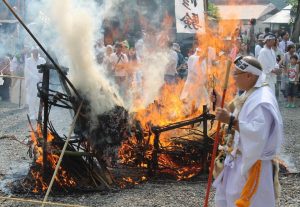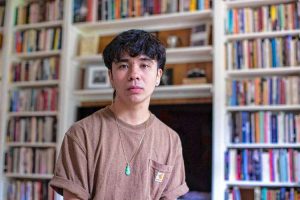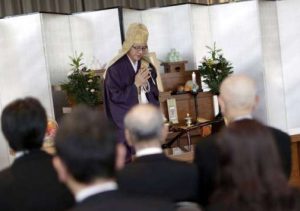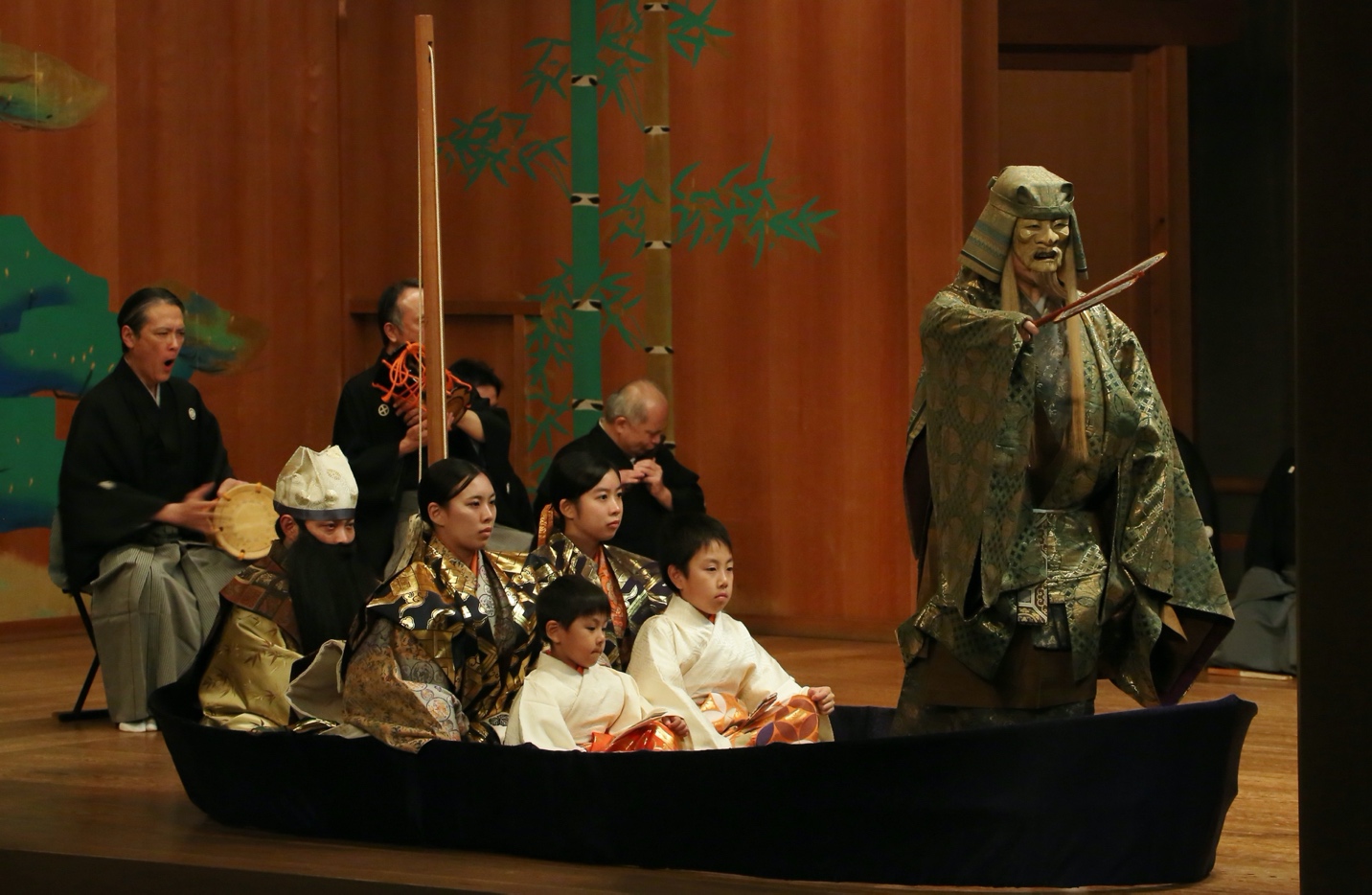
two boy kokata, Satoro Mikata, 6, and Haruka Mikata 11, sons of Noh actor Mikata Madoka;
two girl kokata, Mikata Nodoka, 20, and Mikata Azusa, 15;
daughters of Mikata Shizuka. Musicians: o-tsutsumi (large hip drum) Masaru Dai, 60;
small shoulder drum (ko-tsutsumi)Kichisaka Ichiro, 55;
flute (fue)Ichikaza Sugi, 70. Kanze Kaikan Noh Theater, Kyoto, 7 November 2020.
Image courtesy of Theater Noh
Japanese Noh theater is one of the most august performing traditions in the world. It attains heights of artistry and spiritual awareness rarely reached by other forms of theater. It is considered by some to be the quintessential expression of Japanese aesthetics, and its 14th century founder Zeami Motokiyo, the greatest genius of Japanese aesthetic theory. Whether we want to plumb the profundity of Noh history and how it has survived the past, or whether we want to imagine the future of Noh and other rare arts in our swiftly changing world, one sure place to begin is with Noh now.
In November of 2020, a family clan of Noh performers, lead by Mikata Shizuka, 54, produced a public performance of the Noh play Tousen, or Cathay Boat. It was followed by a performance of a mae bayashi—a dance performance to chanted text extracted from a Noh play. In this case, the famous play Matsukaze. These plays featured six children of Noh families, actors and musicians,
Years ago, as a young man, Mikata Sensei was featured in culture and fashion magazines, listed as among “Japan’s most eligible bachelors,” and was known for his handsome looks, his elegant manners, and his skill in performing Noh, literally bringing people to tears from behind a mask and layered costumes while chanting medieval Japanese. But his nickname then was “The Antique” because of his devotion to the True Art of Noh—a term we will return to later—and his belief in the full artistic power and capacity of his art form. Noh is more than enough. It is endlessly rich with offerings. In all times. Noh exists in an aesthetic eternity.
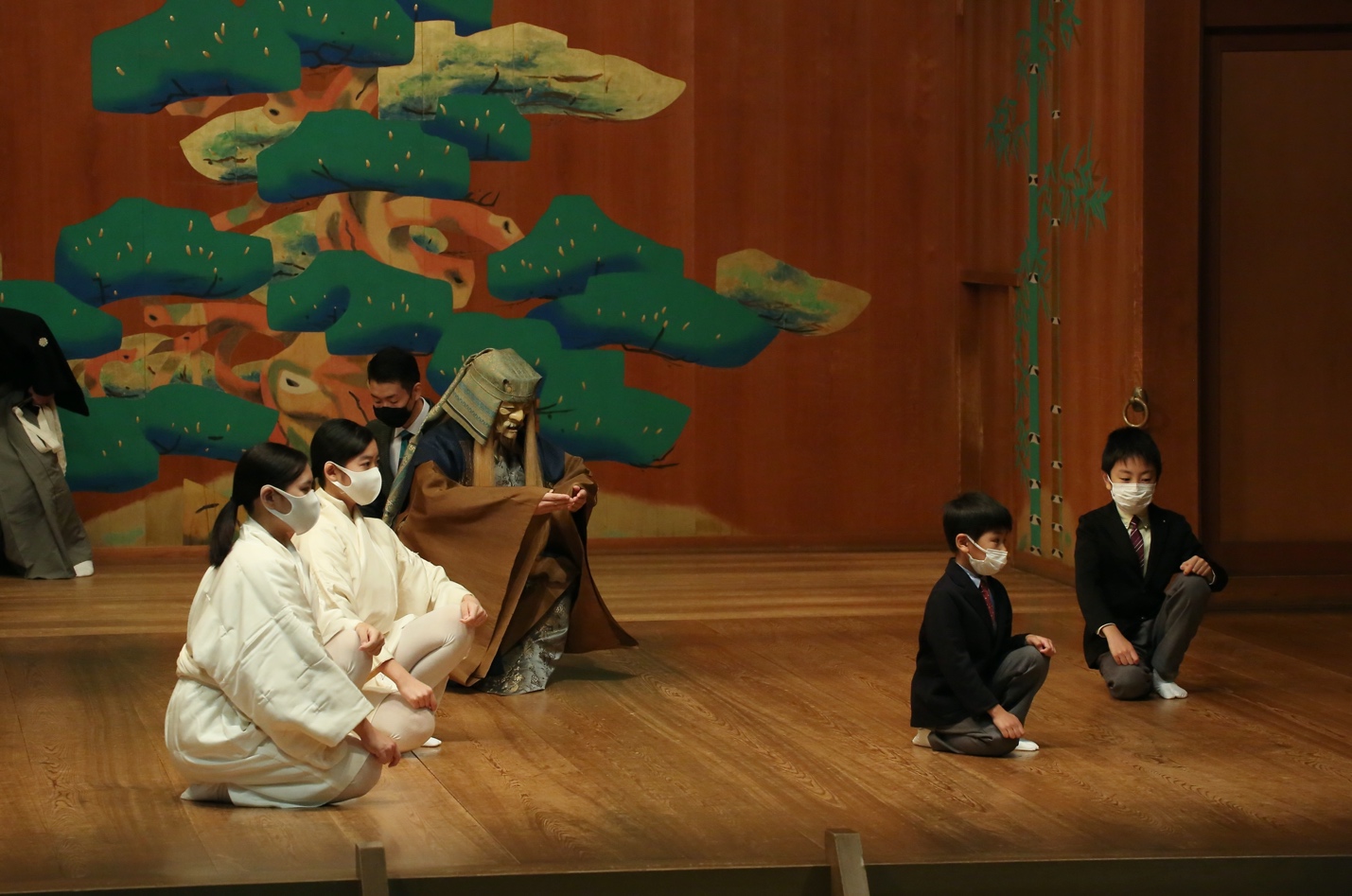
Mikata Satoru and Mikata Haruka. Main actor shite in mask and costume,
Mikata Shizuka. Kanze Noh Stage, Kyoto, 7 November 2020.
Image courtesy of Theater Noh
Fast forward to 2020, and this great Noh actor has three daughters and no sons. These are new times. He teaches his daughters, of whom the youngest, Azusa Mikata, 15, aspires to become a professional Noh actor like her famous father. No one is deluded about the prospects of carrying on a more-than-600-year-old performing tradition, rarified and recondite by design, appealing to the instincts of spirituality, nature, and poetry in an audience that comes—yes of course—for the seamless integration of the arts and the sheer beauty of the theatrical language of Noh, but more than that, they come for the possible experience of hana, or flower.
Nothing is more of the moment than a blossoming flower. Hana is an artistically produced spiritual state shared with an audience whose own concentration factors in the emergence of a shared transcendence of reality; a basic humanity as everything returns to its root. “The essence of art,” wrote Zeami, “Is to unite high and low and bring joy to the hearts of the people.” Noh is Zen as art.
Shizuka’s younger brother, Madoka, is also a well-regarded professional Noh actor. He has two sons, Satoru and Haruka. Shizuka and Madoka’s father, Mikata Ken, is the son of a Buddhist priest. Upon Shizuka’s choice to follow his father, the ancestral temple is now in other hands, all benign. The temple is the location of Mikata Sensei’s lessons. Noh is not an accident for the Mikata clan, it is a choice and a destiny; a vocation. One reason Tousen was selected to be performed, in addition to the poignant plot, is that it offered the rare opportunity to portray four children.
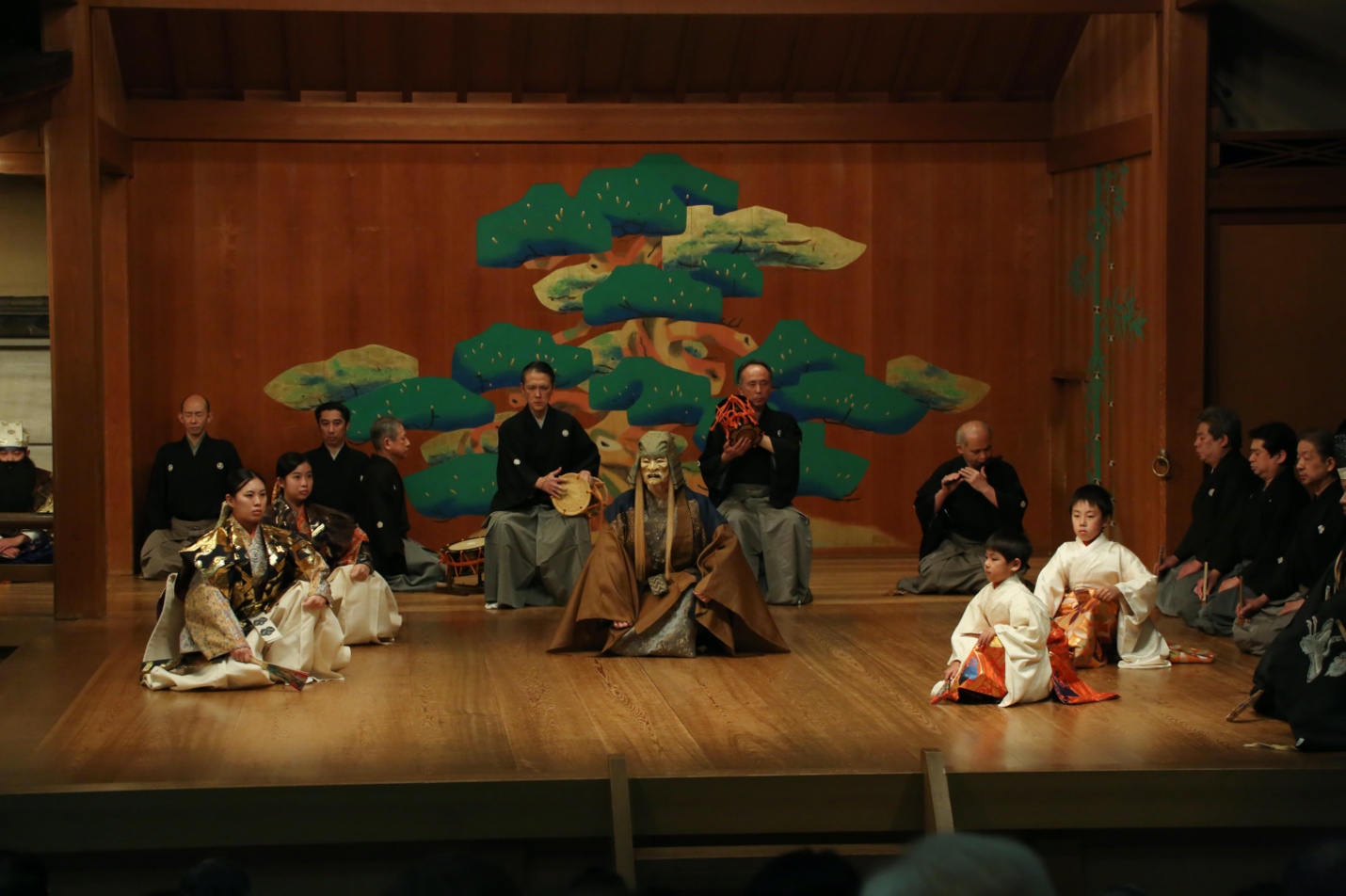
Mikata Shizuka. The father of the two boys, sits to the left of the large hip drum, Mikata Madoka.
The large hip drum player, Masaru Dai, is father to the drummer in the following piece, Matsukaze;
The shoulder drum player, Kichisaka Ichiro, is also father to the drummer in the following piece.
Secondary character on far left in beard. Flute player, Ichikazu Sugi, rear right; chorus on the far right.
Kanze Noh Stage, Kyoto, 7 November 2020. Image courtesy of Theater Noh
Two of the finest Noh drummers, Kawamura Dai, who plays the o-tsutsmi, or large hip drum, and Kichisaka Ichiro, who plays the ko-tsutsumi, or small shoulder drum, shared the day’s stage with their sons, Rintaro, 24, and Rimpei, 13. Like their fathers, long-time colleagues, and friends, the boys have often played Noh together. The fathers provided drums for Tousen and the sons provided drums for Matsukaze.
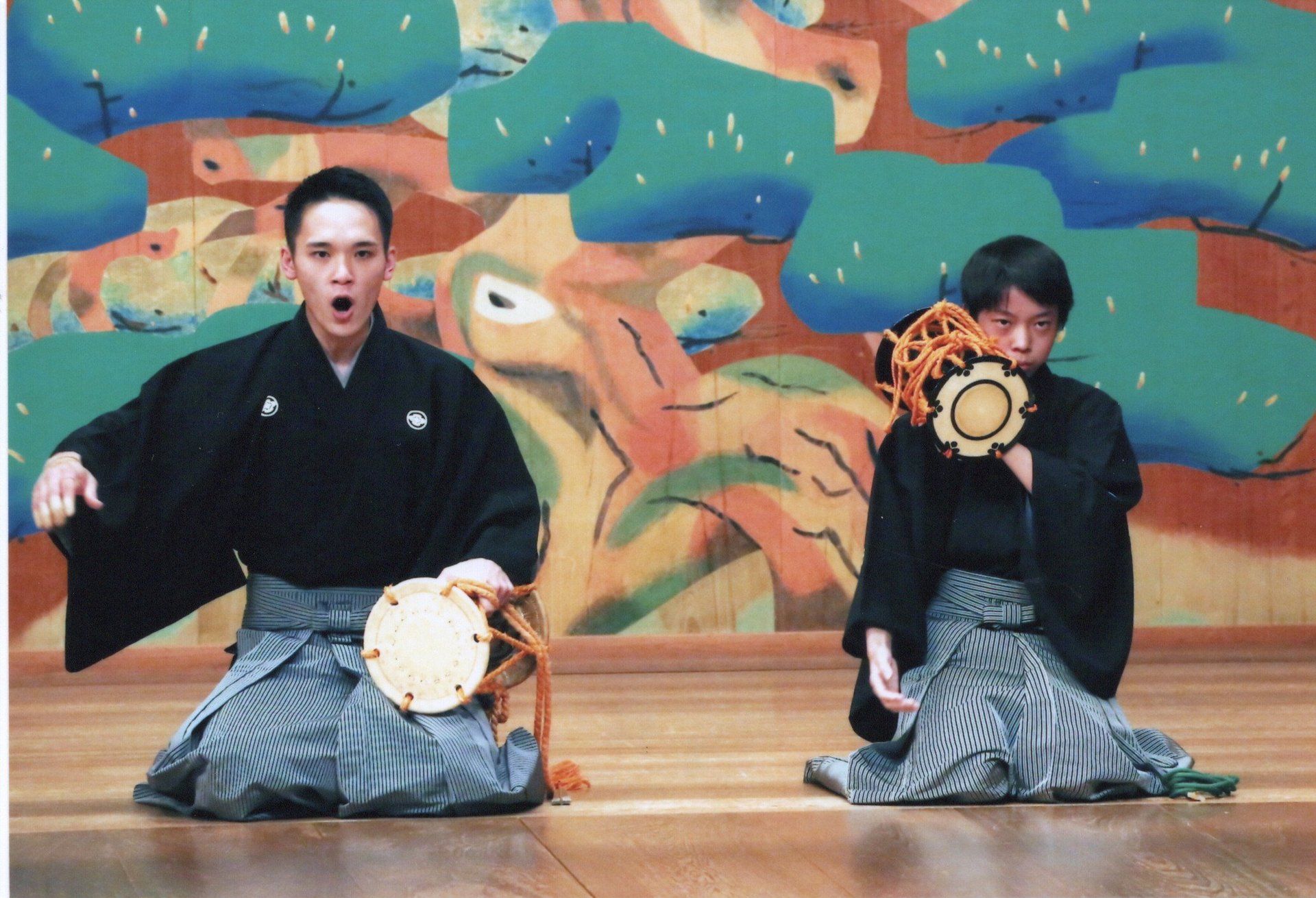
There it is, folks. This is how transmission works. Mikata Shizuka Sensei not only gives complete opportunities to his daughters who bear the illustrious name, but he is holding back daughter Azusa from taking on the world as a female Noh actor as she intends to, until she has completed her traditional training as thoroughly as he did. Azusa is not catching any breaks as she enters this new paradigm of an Age of Women. I can’t wait.
Mikata Azusa, daughter of The Antique, the great Mikata Shizuka, grandson of a Buddhist priest. The world is ready for you, Azusa.
It is breathtaking to think that one of Japan’s most moving Noh actors is training his daughter in this ancient profession because she wants to do it. He knows the superficiality of youth, but who honestly understands anything about today’s culture except the youth?
Zeami warns Azusa anciently to beware of waka no hana, the bloom of youth; to create artistry instead of an eternal nature: Become the cycle upon which the flower can blossom. Is it any wonder that among the seven Noh plays about Japan’s legendary poet and beauty, Ono no Komachi, she is most often depicted at 100 years old, alone, having lost her beauty and her wits?
Instead, in Noh, Komachi is become a Buddha. “Like a root-cut reed . . .” I hope that I live to see Azusa Mikata play Ono no Komachi as the first female Noh actor to rise, now in this 21st century. I hope that all of these children live to carry their arts as their fathers do, as their fathers did. By crazy twists of fate, I know their fathers well. Everyone knows what supreme artists they are. I know what fine people they are. I know the inexpressible respect they have for the life of the True Art of Noh. This, too, is the true Japanese spirit.
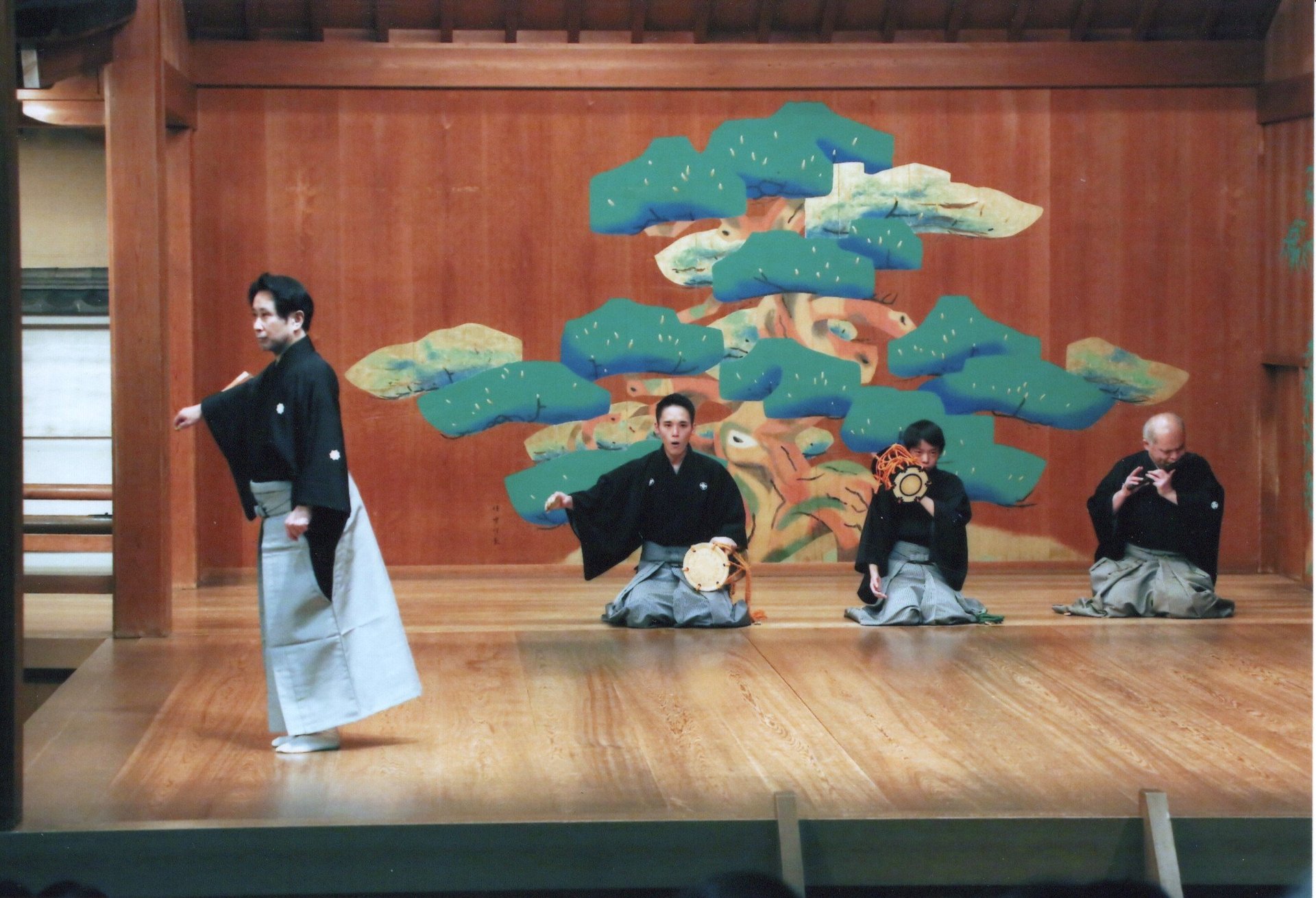
From left: Katayama Kuroemon, 56, son of the late and illustrious arch-conservative Noh actor of
the same name, now bestowed on the young man, portrays the main actor shite.
Large hip drum (o-tsutsumi), Masaru Rintaru, 24; small shoulder drum (ko-tsutsumi), Kichisaka Rimpei, 13;
flute (fue), Ichikazu Sugi, 70. Kanze Noh Stage, Kyoto, 7 November 2020. Image courtesy of Theater Noh
Tousen, a 14th century Noh play about activity during the Tang dynasty, tells the story of Kei, a Chinese soldier captured in a war with Japan and taken to a life of servitude, maintaining lands for a Japanese official. Kei marries a Japanese woman and has two children. After many years, the two children he left behind in China arrive in Japan with all their households’ gifts to secure the release of their father. The Japanese captor was so moved that he agreed to allow Kei to return to China with them, expecting his Japanese children to remain and do the father’s work. Upon their intended departure, his Japanese children come begging him not to leave.
With honor winning the day, Kei is permitted to take his Japanese children with him as well, and returns to the root of his ancestors and art, leading his united family to a loving future together. It is the rare Noh play that includes four children, in fact it is the only Noh play with four children in the plot. Beyond this dramaturgical reality is the beautiful living expression of a family transmission of ancient arts; the very life of Noh now.
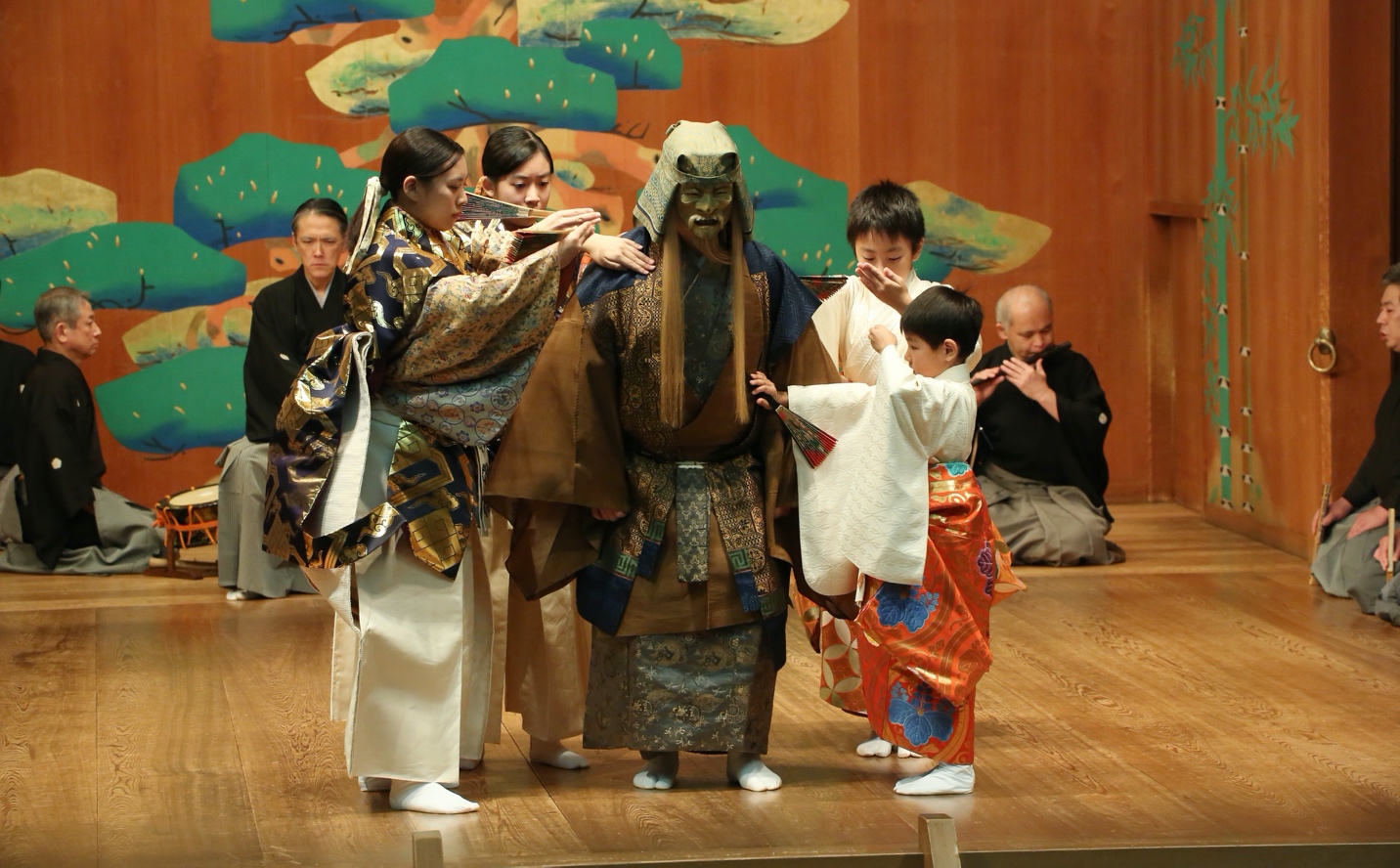
See more









